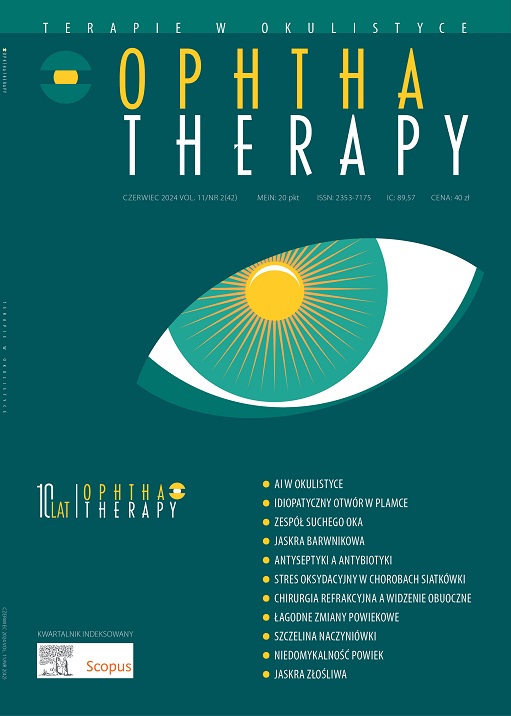Clinical and therapeutic profile of patients with glaucoma treated with latanoprost without macroglycerol-40 hydroxystearate (MGHS-40) – observational study Original research study
Main Article Content
Abstract
Purpose: The aim of the study was to evaluate the clinical and therapeutic profile of patients with open-angle glaucoma (OAG) and intraocular hypertension (IHT) who were treated with latanoprost eye drops without macroglycerol-40 hydroxystearate (MGHS-40).
Methods: This was a multicenter, open-label, observational, non-interventional study evaluating the clinical and therapeutic profile of patients with glaucoma who received therapy with latanoprost eye drops, without MGHS-40. The study, conducted between April 2022 and July 2023, involved 7171 patients and 270 physician-investigators from across the country. The study included adult patients with OAG and IHT in whom the physician made an independent decision to change therapy or include a drug containing latanoprost without MGHS-40.
Results: The results of the study showed that the mean intraocular pressure in this group of patients was 22.6 mmHg. Most of the study participants had a diagnosis of comorbidities – the most common being high blood pressure. Risk factors for OAG were also noted in more than 70% of patients. Predominant among these were a positive family history and smoking.
Conclusion: Our study shows that the latanoprost therapy without MGHS-40 is effective in lowering intraocular pressure. The main factors determining a doctor’s decision to use latanoprost without MGHS-40 were good topical tolerability and a simple formulation. The results suggest that this formulation has properties that could enhance patient compliance, possiblyincreasing long-term intraocular pressure-lowering effectiveness.
Downloads
Article Details

This work is licensed under a Creative Commons Attribution-NonCommercial-NoDerivatives 4.0 International License.
Copyright: © Medical Education sp. z o.o. License allowing third parties to copy and redistribute the material in any medium or format and to remix, transform, and build upon the material, provided the original work is properly cited and states its license.
Address reprint requests to: Medical Education, Marcin Kuźma (marcin.kuzma@mededu.pl)
References
2. Misiuk-Hojło M, Mulak M. Leki bez konserwantów – czy już standard w terapii jaskry? Przegl Okul. 2018; 15(4): 1-2.
3. Polskie Towarzystwo Okulistyczne 2022. Wytyczne diagnostyki i leczenia jaskry (aktualizacja 2022).
4. Smedowski A, Paterno JJ, Toropainen E. Excipients of preservative-free latanoprost induced inflammatory response and cytotoxicity in immortalized human HCE-2 corneal epithelial cells. J Biochem Pharmacol Res. 2014; 2(4): 175-84.
5. Janicki S, Fiebig A, Sznitowska M. Farmacja Stosowana. Podręcznik dla Studentów Farmacji. Wydanie IV uzupełnione. Warszawa 2013.
6. Bacharach J, Ahmed IIK, Sharpe ED et al. Preservative-Free versus Benzalkonium Chloride–Preserved Latanoprost Ophthalmic Solution in Patients with Primary Open-Angle Glaucoma or Ocular Hypertension: A Phase 3 US Clinical Trial. Clin Ophthalmol. 2023; 17: 2575-88. http://doi.org/10.2147/OPTH.S414015.
7. Davuluru SS, Jess AT, Kim JSB et al. Identifying, understanding, and addressing disparities in glaucoma care in the United States. Transl Vis Sci Technol. 2023; 12(10): 18. http://doi.org/10.1167/tvst.12.10.18.
8. Tham Y-C, Li X, Wong TY, Quigley HA, Aung T, Cheng C-Y. Global prevalence of glaucoma and projections of glaucoma burden through 2040: a systematic review and meta-analysis. Ophthalmology. 2014; 121(11): 2081-90. http://doi.org/10.1016/j.ophtha.2014.05.013.
9. Allison K, Patel D, Alabi O. Epidemiology of glaucoma: the past, present, and predictions for the future. Cureus. 2020; 12(11): e11686. http://doi.org/10.7759/cureus.11686.
10. Osial N, Kaczyńska A, Gorecka A et al. Glaucoma – the significant challenge for the healthcare system in Poland. Journal of Education, Health and Sport. 2022; 12(7): 30-39. http://doi.org/10.12775/jehs.2022.12.07.004.
11. European Glaucoma Society Terminology and Guidelines for Glaucoma, 5th ed. Br J Ophthalmol. 2021; 105(Suppl 1): 1-169.
12. Alm A. Latanoprost in the treatment of glaucoma. Clin Ophthalmol. 2014; 8: 1967-85. http://doi.org/10.2147/OPTH.S59162.
13. Jóhannesson G, Stille U, Taube AB et al. Guidelines for the management of open-angle glaucoma: National Program Area Eye Diseases, National Working Group Glaucoma. Acta Ophthalmol. 2024; 102(2): 135-50. http://doi.org/10.1111/aos.16599.
14. Alm A, Camras CB, Watson PG. Phase III latanoprost studies in Scandinavia, the United Kingdom and the United States. Surv Ophthalmol. 1997; 41(Suppl. 2): S105-10.
15. Harasymowycz P, Hutnik C, Rouland JF et al. Preserved Versus Preservative-Free Latanoprost for the Treatment of Glaucoma and Ocular Hypertension: A Post Hoc Pooled Analysis. Adv Ther. 2021; 38(6): 3019-31. http://doi.org/10.1007/s12325-021-01731-9.
16. Lee JW, Ahn HS, Chang J, Kang HY et al. Comparison of Netarsudil/Latanoprost Therapy with Latanoprost Monotherapy for Lowering Intraocular Pressure: A Systematic Review and Meta-analysis. Korean J Ophthalmol. 2022; 36(5): 423-34. http://doi.org/10.3341/kjo.2022.0061.
17. Reisner P, Malukiewicz G. Diagnostics, classification and treatment of dry eye syndrome in the era of COVID-19. Klinika Oczna / Acta Ophthalmologica Polonica. 2021; 123(1): 8-13. http://doi.org/10.5114/ko.2021.104746.
18. Nijm LM, Schweitzer J, Gould Blackmore J. Glaucoma and Dry Eye Disease: Opportunity to Assess and Treat. Clin Ophthalmol. 2023; 17: 3063-76. http://doi.org/10.2147/OPTH.S420932.
19. Chen HY, Lin CL, Tsai YY et al. Association between glaucoma medication usage and dry eye in Taiwan. Optom Vis Sci. 2015; 92(9): e227-32. http://doi.org/10.1097/OPX.0000000000000667.
20. Baudouin C, Renard JP, Nordmann JP et al. Prevalence and risk factors for ocular surface disease among patients treated over the long term for glaucoma or ocular hypertension. Eur J Ophthalmol. 2013; 23(1): 47-54. http://doi.org/10.5301/ejo.5000181.
21. Gasser P, Flammer J. Blood-cell velocity in the nailfold capillaries of patients with normal-tension and high-tension glaucoma. Am J Ophthalmol. 1991; 111: 585-8. http://doi.org/10.1016/S0002-9394(14)73703-1.
22. Gasser P, Flammer J, Guthauser U et al. Do vasospasms provoke ocular diseases? Angiology. 1990; 41: 213-20. http://doi.org/10.1177/000331979004100306.
23. Gasser P. Ocular vasospasm: a risk factor in the pathogenesis of low-tension glaucoma. Int Ophthalmol. 1989; 13: 281-90. http://doi.org/10.1007/BF02280088.
24. Huang JY, Su CC, Wang TH et al. Migraine and increased risk of developing open angle glaucoma: a population-based cohort study. BMC Ophthalmol. 2019; 19: 50. https://doi.org/10.1186/s12886-019-1062-9.
25. Epstein SP, Ahdoot M, Marcus E et al. Comparative toxicity of preservatives on immortalized corneal and conjunctival epithelial cells. J Ocul Pharmacol Ther. 2009; 25(2): 113-9.

